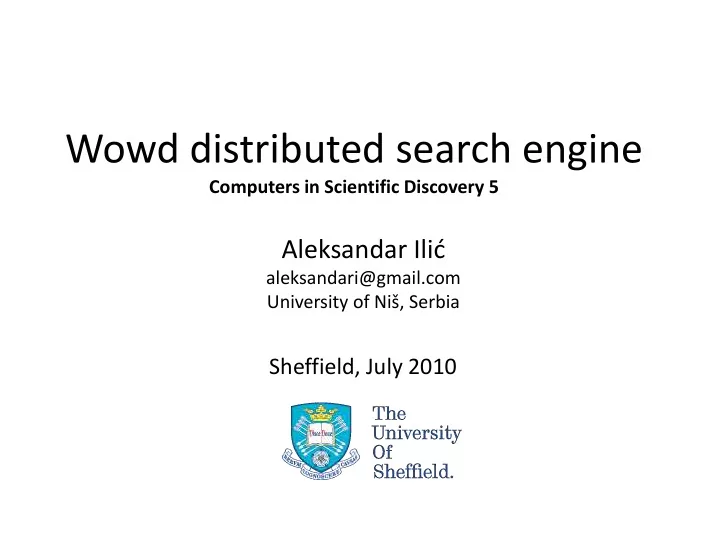

Wowd distributed search engine Computers in Scientific Discovery 5 Aleksandar Ili d aleksandari@gmail.com University of Ni š, Serbia Sheffield, July 2010
• Wowd – Distributed P2P real-time discovery & search engine – http://www.wowd.com/ • Graphs in Wowd – routable graphs – ranking in internet graph – ranking in social graph
Background • Founded by Borislav Agapiev in 2007 • Development team is completely in Serbia (JAVA) • Investors are USA venture capital firms – Draper Fisher Jurvetson, KPG Ventures, Stanford University • Research in many cutting-edge fields • Studying topology and traffic of large-scale networks
What is Wowd?
Age of Information Finding meaning in unstructured data requires using different techniques: • Google’s PageRank - finding the relative importance of web pages for searching. • Social Network Analysis - finding how groups are divided, who is the most popular and who hangs out with who… • Bioinformatics - find which proteins function similarly. • Pattern Matching - given a pattern find all the instances of a subgraph of this pattern.
Reference search vs. Real-time discovery Google: reference search I am looking for information on X (1) Think of something (2) Go to Google, type it in, hit enter (3) Look through the results, refine query as needed Wowd: discovery in real-time I am watching for developments (in X) (1) Wonder what’s going on (2) Go to Wowd, look at the Hot List, Hot Topics (3) Click on a topic of interest, watch new material roll in
Graphs in Wowd • construction of routable graph of computers – millions of vertices • ranking in internet graph – from 100 million to tens of billion of vertices • ranking in social graph – 10-100 million of vertices • graphs in bioinformatics – from 100 vertices to 100 million of vertices (proteins, molecules, atoms)
Routable graphs • set of nodes (computers) in a distributed network • how can any node get to any other node – as fast as possible • create an algorithm for constructing a graph
Routable graphs • vertices are labeled – random binary 64bit number • directed • routable – must be possible to find a path to any label – labels of neighbors (only) are known 3 path from 5 to 4? 5 7 1
Routable graphs • structure must be defined – ordering: • each vertex must have connection to first lower and first higher • skip lists: 0 1 2 3 4 5 6 7 – distance: • for any label, each must have connection to at least one with closer label • XOR distance: 0 1 2 3 4 5 6 7
Routable graphs • routable k-connected – only findable paths are considered • Dynamic – adding and removing vertices, while keeping requirements – locality of change – adding vertex ( only edges to and from it can be added) – removing vertex ( only edges instead of removed ones are allowed) • degree of nodes is limited – maintenance limit
Routable graphs 1… 01… 10… 11… 001… 0001… 00001… 100… 101… 110… 111… 000001 … 00000000
Routable graphs – in numbers |V(G)| Max degree Average distance Theoretical optimum Average/Theor. 2 10 (1K) 191 1.89 1.81 1.04 2 15 (32K) 351 2.77 1.99 1.39 2 20 (1M) 511 3.62 2.75 1.32 2 22 (4M) 575 3.93 2.92 1.35 2 24 (16M) 639 4.29 2.98 1.44 Note: theoretical optimum with respect to only max degree constraint
Degree/diameter problem • Given natural numbers Δ and D , find the largest possible number of nodes n Δ ,D in a graph of maximum degree Δ and diameter D . • Moore bound: 2 1 D 1 ( 1 ) ( 1 ) ... ( 1 ) n , D • Open question : Does there exist a Moore graph of diameter 2 and degree 57?
Ranking in internet graph • set of internet pages • structure – links between them • how to rank/sort them?
Ranking in internet graph • random surfer model • rank of pages = probability on being on each page • if A is adjacency matrix, it becomes: ( 1 ) r Ar • converges if sum of each row is ≤1 • solution is largest eigenvalue
Ranking in internet graph 28% 23% 25% 16% 24% 21% 1 1 1 Edge weights: 0.6 0 1/3 0.2 1/3 0.3 1 – uniform 1 1 1 21% 7% 13% 1 1 1 ( , ) e u v 0.8 1/3 0.1 | ( ) | N u 1/2 0.2 0.8 • Google’s PageRank 1/2 0.2 0.8 26% 23% 24% 9% 17% 23% – actual probability of surfer following that link • ours EdgeRank (patented) • simplified: count clicks on each link, and use: ( , ) c u v ( , ) e u v ( , ) c u t ( ) t N u
Ranking in internet graph Distributed iterative calculation • number of needed iterations is small – initial: 5-10 iterations – new pages: 2-3 iterations • and trivially distributed ( G ) O n E iter
Ranking in social graph • set of social users – Twitter users • graph publicly available • directed social graph • how to rank/sort them? – needed to best use attention frontier • same idea – random walk
Applications • Global alignment of multiple protein-protein interaction networks (undirected collection of pair wise interactions on a set of proteins): Given a pair of weighted PPI networks (and a list of pair wise sequence similarities between proteins in the two networks) we need to find the best overall match between these networks. • Distributed and scalable solution for the existing biological databases
Thank you!
Recommend
More recommend